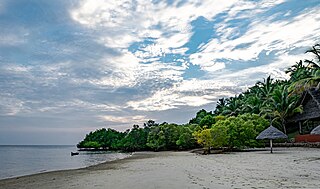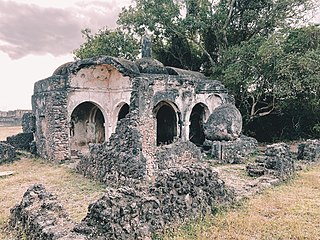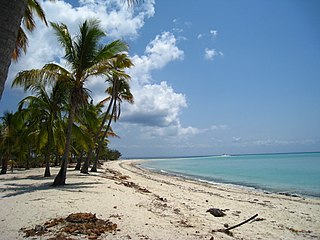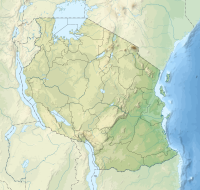
Mafia Island or Chole Shamba is an island of The Mafia Archipelago located in Mafia District in the southern Pwani Region of Tanzania across the Mafia Channel. The island is the third largest in Tanzanian ocean territory, but is not administratively included within the semi-autonomous region of Zanzibar, which has been politically separate since 1890. Mafia Island forms the largest part of Mafia District, one of the six administrative districts in the Pwani Region. As the Mafia Archipelago's main islan, is sometimes called Chole shamba in meaning Chole farmlands Swahili. This is in opposition to the historic settlement of Chole Mjini(Chole town) on Chole Island inside Mafia Bay. The island's population is over 40,000. The economy is based on fishing, subsistence agriculture and the market in Kilindoni. The island attracts some tourists, mainly scuba divers, birdwatchers, game fishermen, and people seeking relaxation.

Kilwa Kisiwani is an island, national historic site, and hamlet community located in the township of Kilwa Masoko, the district seat of Kilwa District in the Tanzanian region of Lindi Region in southern Tanzania. Kilwa Kisiwani is the largest of the nine hamlets in the town Kilwa Masoko and is also the least populated hamlet in the township with fewer than 1,000 residents.

Kilwa District is one of six administrative districts of Lindi Region in Tanzania. The District covers an area of 15,000 km2 (5,800 sq mi). The district is comparable in size to the land area of the nation state of East Timor. Kilwa district is bordered to the north by Rufiji District in Pwani Region, to the east by the Indian Ocean, to the south by the Lindi District, Nachingwea District together with Ruangwa District, and to the west by the Liwale District. The district borders every other district in Lindi Region except Lindi Municipal District. The district seat (capital) is the town of Kilwa Masoko. The district is named after the medieval Swahili city state of Kilwa Kisiwani. According to the 2012 census, the district has a total population of 190,744.

Lindi Region is one of Tanzania's 31 administrative regions. The region covers an area of 66,040 km2 (25,500 sq mi). The region is comparable in size to the combined land area of the nation state of Sri Lanka. The regional capital is the municipality of Lindi.

Kilwa Masoko or Masoko is an administrative ward in Kilwa District of Lindi Region in Tanzania. The ward covers an area of 200 km2 (77 sq mi), and has an average elevation of 11 m (36 ft). The ward is also the capital of Kilwa District. According to the 2012 census, the ward has a total population of 13,601.
The Matumbi are a Bantu ethnolinguistic group native to Kilwa District, Lindi Region in southern Tanzania, who speak the Matumbi language. They are also the native inhabitants of the Songosongo island archipelago. Their homeland is also south of the Rufiji delta in southern Pwani Region in Rufiji District. In 1978 the Matumbi population was estimated to number 72,000. They are the largest ethnic group in Kilwa District. The Matumbi Highlands are named after them.
João Vieira and Poilão Marine National Park is a national park in Guinea-Bissau. It was established in August 2000. It covers an area of 495.0 square kilometres (191.1 sq mi) and includes the uninhabited islands of João Vieira, Cavalos, Meio and Poilão, in the southeastern part of the Bijagós Archipelago. The beaches of the islands are frequented by the sea turtle species Chelonia mydas, Eretmochelys imbricata and Lepidochelys olivacea.

Mafia District Council(Wilaya ya Mafia, in Swahili) is one of six administrative districts of Pwani Region in Tanzania. It administers not only the main Mafia Island but the entire Mafia Archipelago. The District covers an area of 642.6 km2 (248.1 sq mi). The Sea of Zanj completely encircles the District. Rufiji District is located on the other side of the Mafia Channel to the west. The district is comparable in size to the land area of Saint Lucia. The town of Kilindoni serves as its administrative capital. The District is home to the largest concentration of Whale Sharks in Africa, Mafia Island Marine Park, Historic Chole Island Ruins, Kisimani Mafia and Kua Ruins; and Mlola Forest Reserve. According to the 2012 Tanzania National Census, the population of the District was 46,438.

Songo Songo Island or sometimes spelled, Songosongo Island is a coral island in the Songosongo Archipelago. The island is governed by the Songosongo ward in Kilwa District of Lindi Region in Tanzania's Indian ocean coast. It is served by the Songo Songo Airstrip. The island's native inhabitants are the Matumbi people.
Latham Island, known locally as Fungu Kizimkazi is an isolated island 43km east Kigamboni in the Dar es Salaam Region of Tanzania. The island geographically considered a part of the Zanzibar Archipelago of Tanzania, it was once politically under the Sultanate of Zanzibar from 1898 to 1963. Currently, the island is administered by the United Republic of Tanzania.

Songo Mnara is a historic Swahiili settlement in located on Songo Mnara Island in Pande Mikoma, Kilwa District in Lindi Region of Tanzania. The island is home to a Medieval Swahili stone town. The stone town was occupied from the 14th to 16th centuries. Songo Mnara has been recognized as a UNESCO World Heritage Site, along with nearby stone town Kilwa Kisiwani. In total, archaeologists have found six mosques, four cemeteries, and two dozen house blocks along with three enclosed open spaces on the island. Songo Mnara was constructed from rough-coral and mortar. This stonetown was built as one of many trade towns on the Indian Ocean. The site is a registered National Historic Site.
Poilão is a small uninhabited island in the Bijagós Archipelago of Guinea-Bissau. It contains the country's southernmost point, at 10°51'53"N,15°43'36"W. It is part of the João Vieira and Poilão Marine National Park. The island is heavily forested. The nearest islands are Meio, 7 nmi (13 km) to the north, Cavalos, 9 nmi (17 km) to the north and João Vieira, 11 nmi (20 km) to the north-northeast. Its area is 43 ha. Between ca. 7000 and 29,000 green sea turtle nests are laid per year at the globally important site of Poilão Island. There is a lighthouse on the island, with focal height 27 m (89 ft).
The East African coral coast is a marine ecoregion along the eastern coast of Africa. It extends along the coasts of Kenya, Tanzania, and northern Mozambique, from Lamu in Kenya to Angoche in Mozambique. It adjoins the Northern Monsoon Current Coast ecoregion to the north, and the Bight of Sofala/Swamp Coast ecoregion to the south.
Songosongo is an administrative ward in Kilwa District of Lindi Region in Tanzania. The ward covers an area of 8.5 km2 (3.3 sq mi), and has an average elevation of 11 m (36 ft). According to the 2012 census, the ward has a total population of 3,056. The ward administers the whole archipelago of the Songosongo Islands, which are composed of 22 coral reefs and 4 coral islands; Songo Songo Island, Fanjove Island, Nyuni Island and Okuza Island. The islands ward's native inhabitants are the Matumbi people. The archipelago is composed of 21 coral reefs including the 4 islands. The ward seat is Songosongo village. In addition there are four hamlets on the islands; Pembeni, Makondeni, Msitumani and Funguni.

The Songosongo Archipelago or The Songosongo Islands is an group of islands in Kilwa District of Lindi Region's coast on the Sea of Zanj in Tanzania's Indian Ocean coast. The archipelago is composed of 21 coral reefs including the 4 coral islands. In total, the archipelago covers a land area of 8.5 km2 (3.3 sq mi), and has an average elevation of 11 m (36 ft). The four Islands in the archipelago are Fanjove, Nyuni Island, Songo Songo and Okuza Island. Tanzania's geological history is very similar to that of Western Australia's northwest shelf. It has rifting from the late Jurassic, then sags in the Cretaceous and Tertiary continental shelves. The largest natural gas deposits in Tanaznia are located in the Songosongo archipelago. The Islands have been found to contain 20 million tonnes worth of natural gas within the archipelago.
Okuza Island is a coral island in Songosongo ward in Kilwa District of Lindi Region in Tanzania's Indian ocean coast. Geographically, the island is part of the Songosongo Islands archipelago which is composed of 22 reefs and 4 islands. The other three islands are Songo Songo, Fanjove Island and Nyuni Island.
Nyuni Island is a coral island in Songosongo ward in Kilwa District of Lindi Region in Tanzania's Indian ocean coast. Geographically, the island is part of the Songosongo Islands archipelago which is composed of 22 reefs and 4 islands. The other three islands are Songo Songo, Fanjove Island and Okuza Island. Nyuni island has an elevation of 14m.
Bwejuu Island is an island of the Mafia Archipelago located in Kilindoni ward of Mafia District in southern Pwani Region of Tanzania. After Jibondo Island, which is to its east, the island is the fourth largest in the archipelago. Mafia Island is to the east, and the Mafia Channel is to the west and south of the island.








